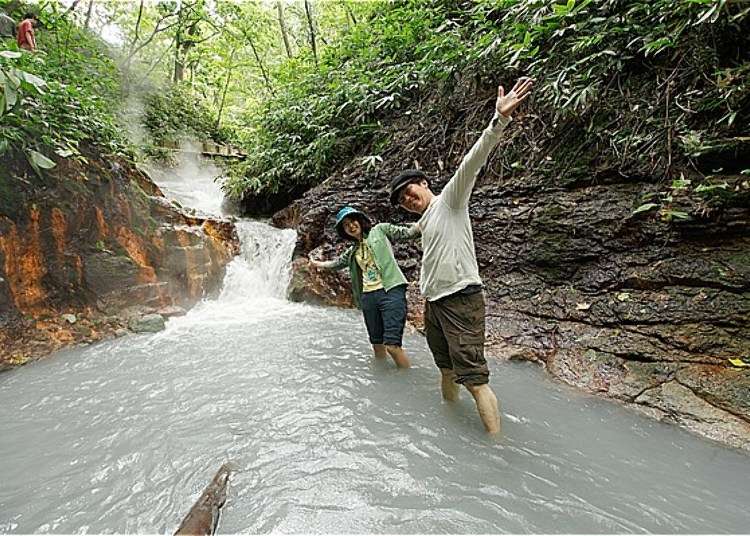
Noboribetsu Onsen in Hokkaido is well known for its 9 different types of hot springs. There are lots of sights to see centered around these hot springs. Jigokudani (literally, "Hell Valley"), for example, exudes both gases and hot water, and Oyunuma, a super high-temperature spring, accumulates sulfur.
In order to see these springs for ourselves, I decided to take a guided tour of Noboribetsu. It even ended in a natural footbath! This was truly the best tour I've ever experienced!
*Taisho Jigoku and Oyunuma River Natural Footbath will be closed off from Nov 6, 2016. (You can walk up to Oyunuma). Date of reopening not yet decided. (As of May, 2018)
Gateway to hell! Walking through Noboribetsu Jigokudani Hell Valley
I booked my tour through the Noboribetsu Gateway Center, which provides guided tours and activities such as nature walks in the town of Noboribetsu Onsen. Of their different course options, I went with their “Geyser Watching” walking tour, which takes you to the geysers and ancient forests of Noboribetsu Onsen in about 2 and a half hours.
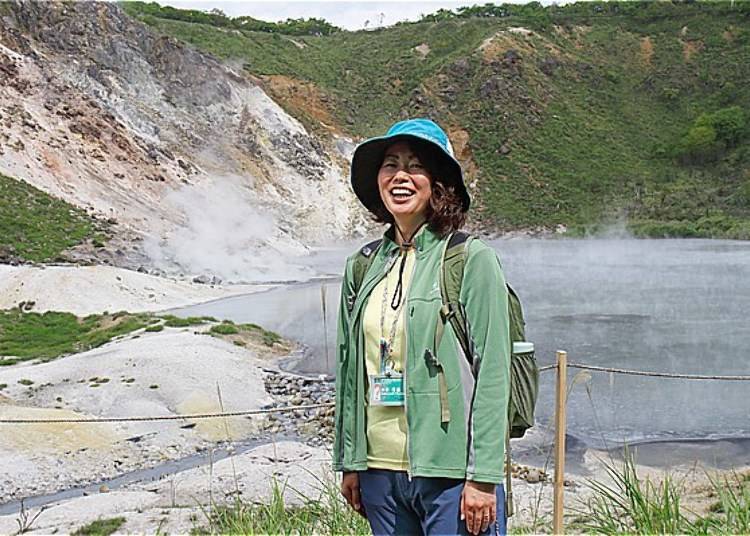

Our first stop was the classic point of Noboribetsu, Hell Valley. Though only a few minutes away, we leisurely strolled for 15 minutes while listening to the guide’s explanations along the way.

At the top of Sengen Park is an observation deck that overlooks Hell Valley.

A Hell Valley is a desolate stretch of land where no plants grow, strewn with rocks, gravel, and the remnants of volcanic activity. Water, hot steam, and volcanic gases leak from the ground in some areas, and geysers may erupt in the others.
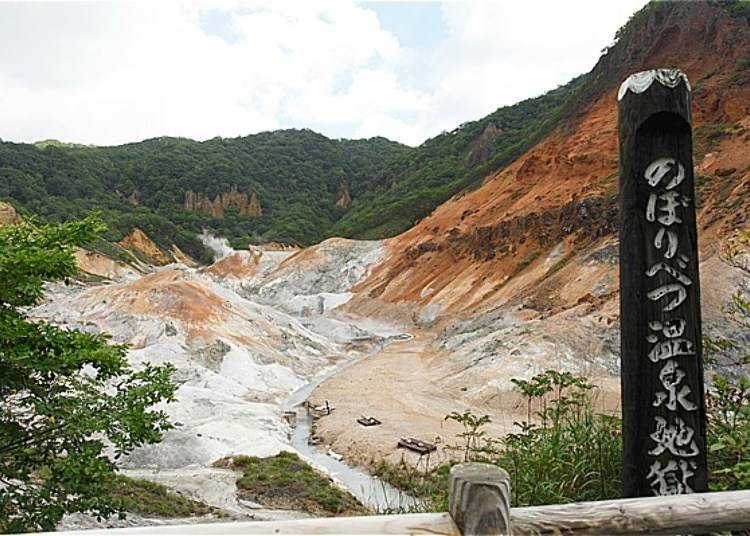
There are 24 sources of water currently in use throughout the hotels of Noboribetsu Onsen. Six of them are here in Hell Valley, and the characteristics of each of these sources is very diverse.
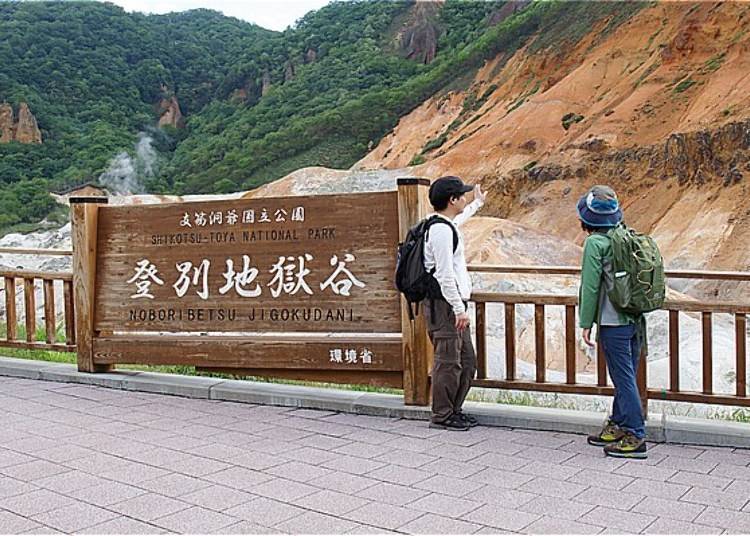
We continue along the footpath through the mountains, onto the side street, and down the stairs. Here we reach the observation space at the bottom of Hell Valley. A small company called Yakushido sits in one corner, with an alum spring gushing right out from the side.
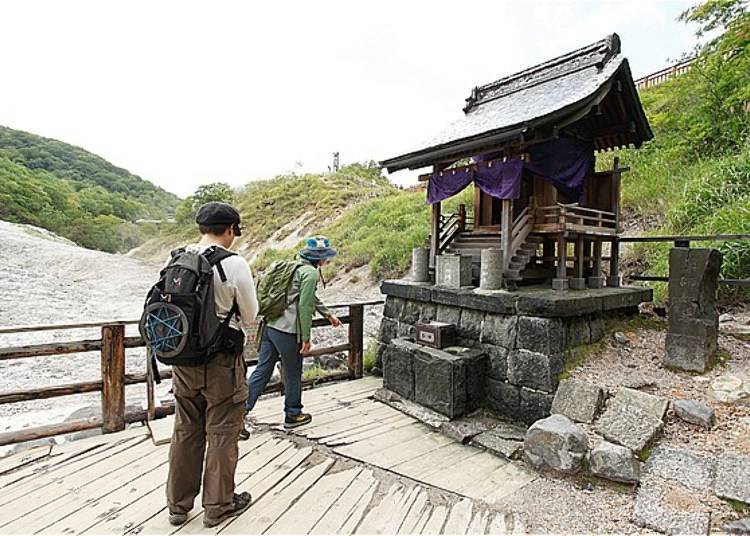
I was told a story of some sulfur miners during the Meiji era who damaged their eyes while working at Noboribetsu. Legend has it when they washed their eyes at this alum fountain, they were miraculously healed. Because of this, it is also referred to as “water of the eyes”.
After this we climbed the stairs returning to the original road, and continued with our guided tour.
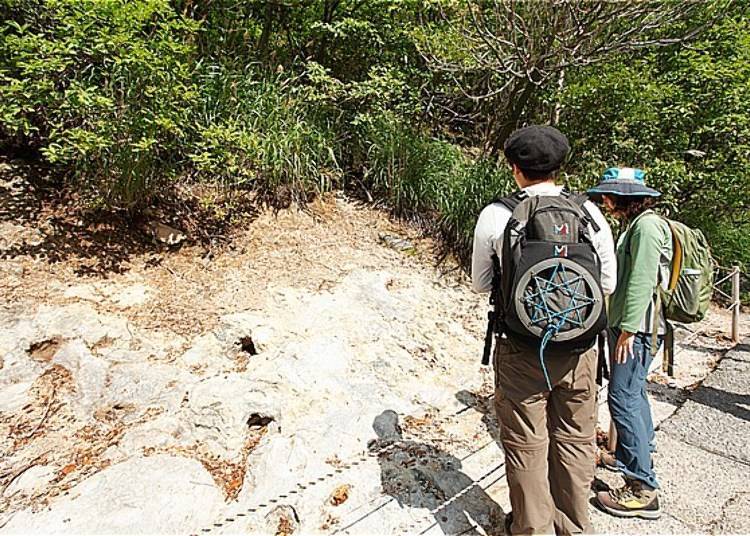
Next, we came to a fork in the road. We continued down a tree-lined path that leads into the middle of Hell Valley.
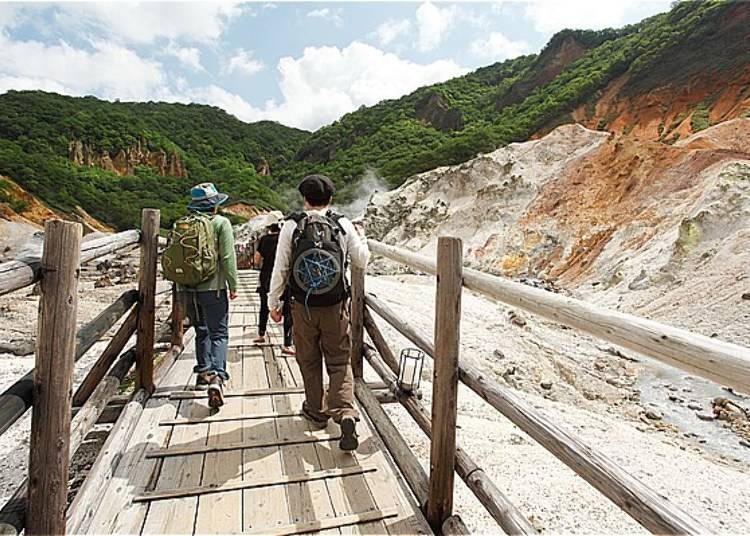
A desolate landscape devoid of any plant or animal life at all spread as far as the eye could see. It truly felt like walking through hell. A small river in the middle of Hell Valley flows with the water of various hot springs pouring in and mixing with the flow.
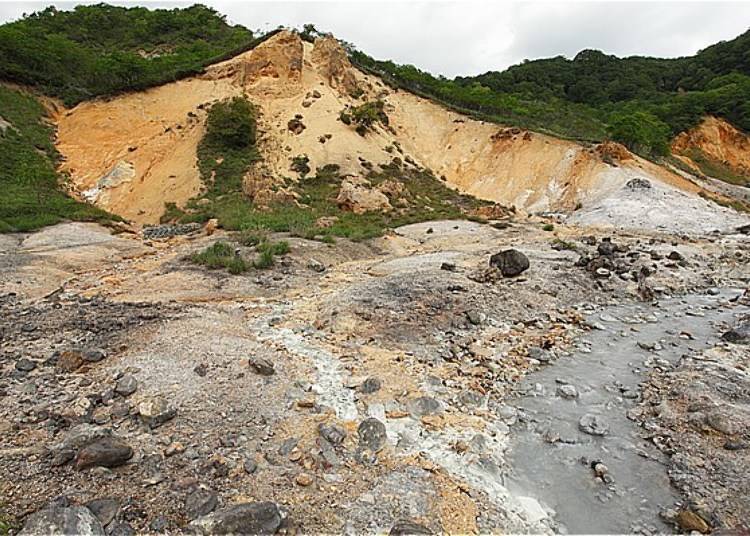
Mr. Kobayashi: “Question time: what is the name of the river that flows through hell?”
Me: “Um, ‘Hell River?’”
Mr. Kobayashi: “You know, I always ask this question during tours. Most people get it right on their first try, but...”
Me: “Oh... is that so... I’m sorry, I have no idea...”
Mr. Kobayashi: “It’s the River Styx.”
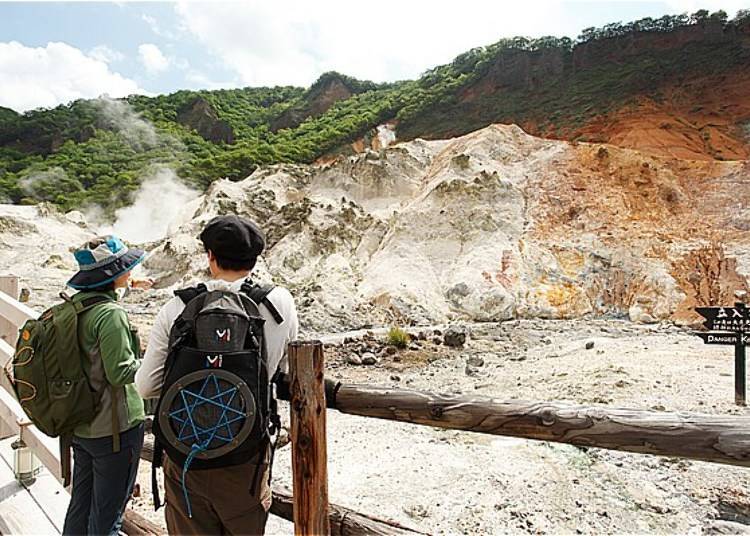
After recovering from my brief embarrassment, we crossed the Sanzu River right into the world of Hell. At the end of the path lies Tessen Pond.
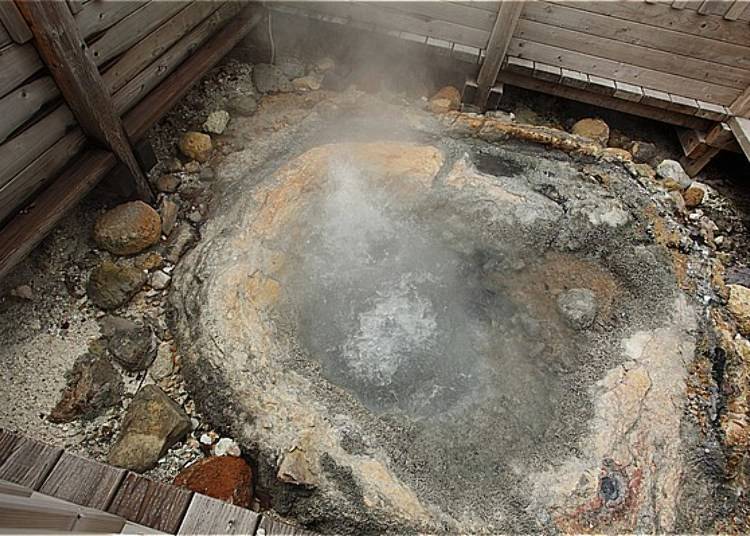
As the hot water accumulates the pond lets out some steam, and the hot water gradually flows out. However every ten minutes or so, the hot water erupts right from the pond as if pushed out by a pump! (The time intervals and amount of water are not always constant.)
It is such an interesting sight, watching the water burst forth like that. The metallic odor of sulfur also wafts out with the steam.
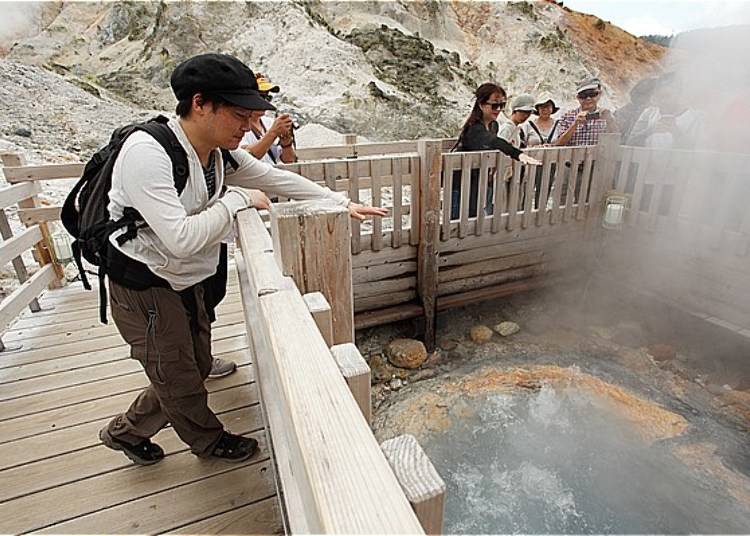
"The main source of this hot spring is the same alum spring as before, which is said to be good for the eyes." At these words, I wanted to jump in.
“But,” he continued, “that doesn’t necessarily mean it can magically cure eye diseases or near-sightedness.”
On second thought...
After experiencing the power of this “hell on earth” a bit longer, we headed to Oyunuma.

On to Oyunuma and Okunoyu
We continued along the mountain path which was now dense with primitive forest. Since it was a mountain path, there were many steep slopes and staircases to climb.
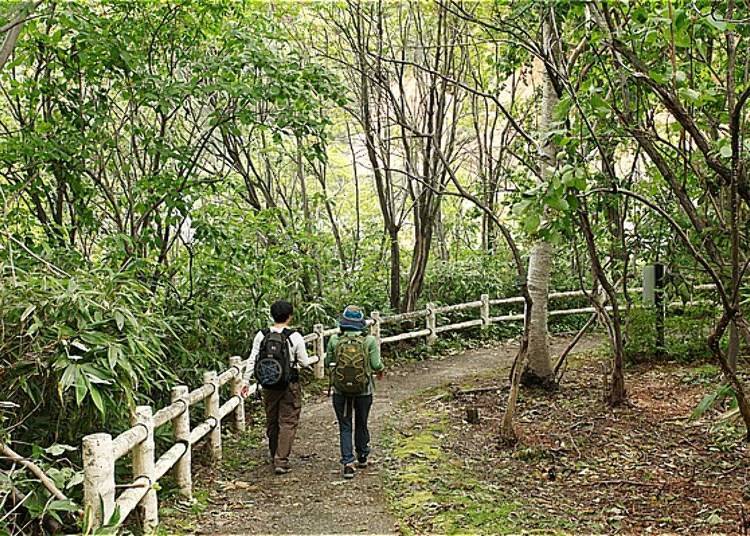
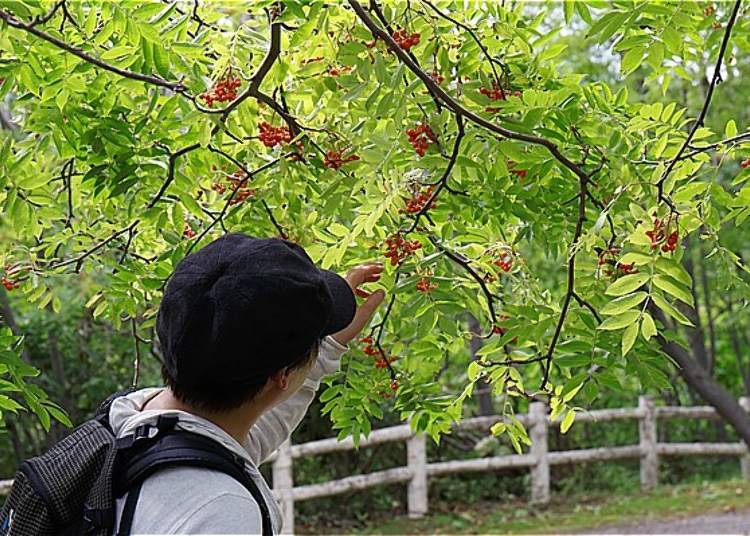
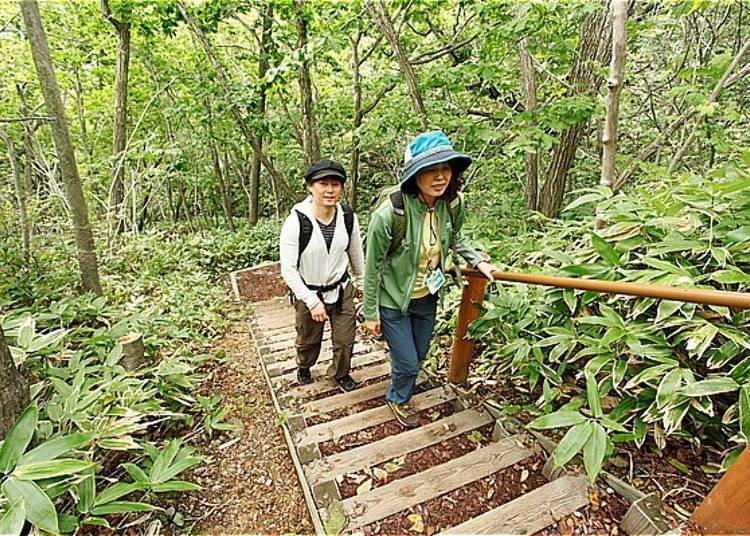
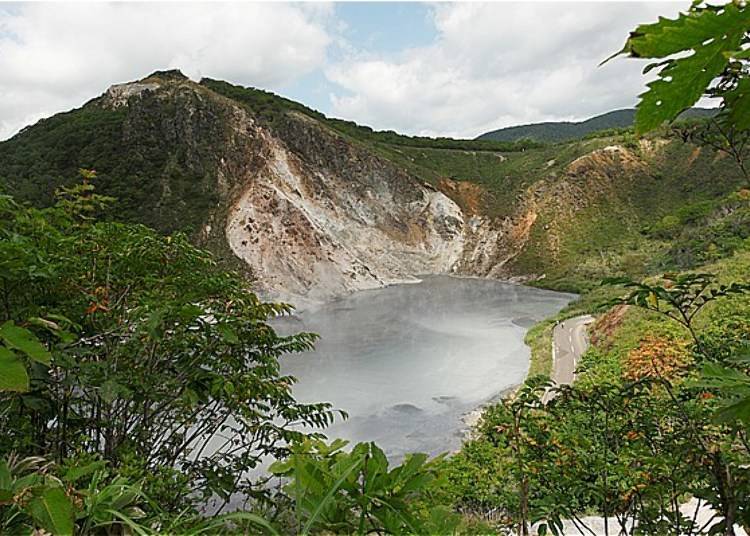
On the way down the mountain, a few minutes from Hell Valley, you can see Okunoyu. It was created by the remnants of the eruption of Mount Hiyoriyama, and lies just across Oyunuma. Several of Noboribetsu's hotels source their hot water from here.
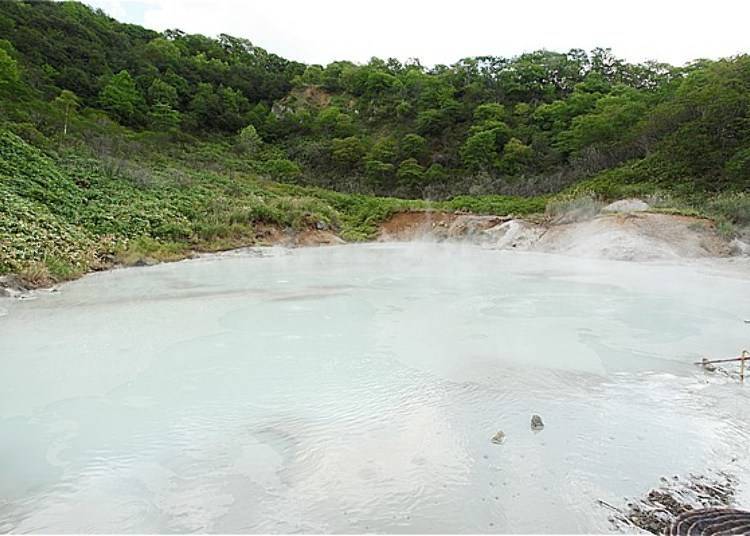

The area from which the water erupts is not consistent, and has burst forth from different parts of the spring, including sometimes from right underneath the deck! Because of this, certain parts of the observatory are off-limits, since it is hard to predict if and when that might happen again.
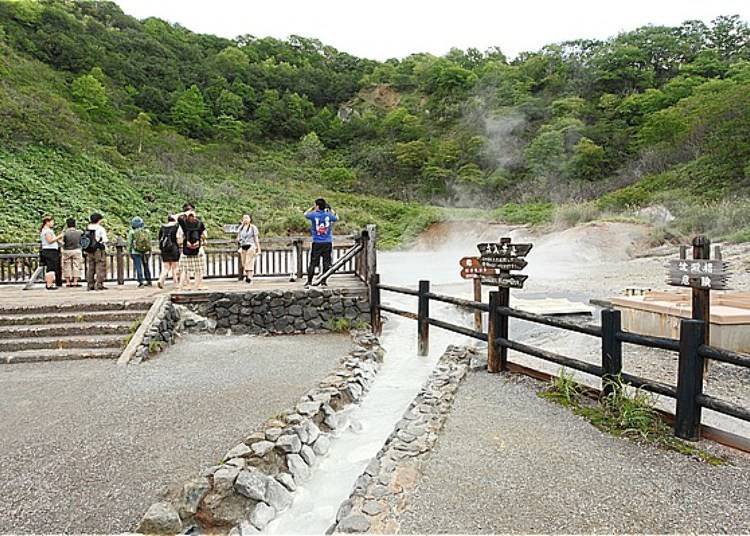
Just like Okunoyu, Oyunuma is a sulfur spring with a surface temperature of 40-50 degrees Celsius, yet can gush out water as hot as 130 degrees. During the Meiji Era, people even built rafts on these hot swamps above the sulfur deposits below. I was shocked at how people could have worked under such extreme conditions. It was like working in a sauna!
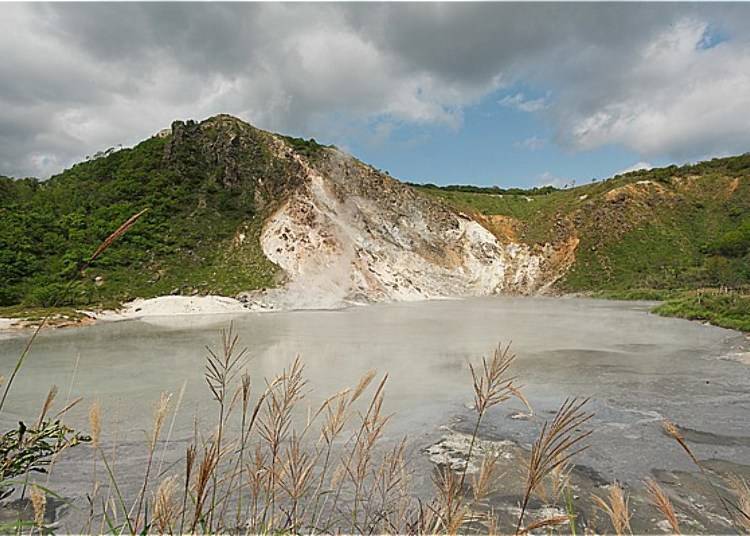

Ending on the right foot with a healing natural footbath!
After that, we headed to the highlight of the trip: the Oyunuma River Natural Foot Bath! The water that overflows from Oyunuma Swamp comes down as a sizable river called the Oyunuma River. Along the banks you can enjoy a natural footbath.
About 10 minutes along the way we came upon Taisho Jigoku, a hot springs of about 10 meters long, created by a small eruption from the time of the Taisho Era. The water from here also flows down, joining with the Oyunuma River.
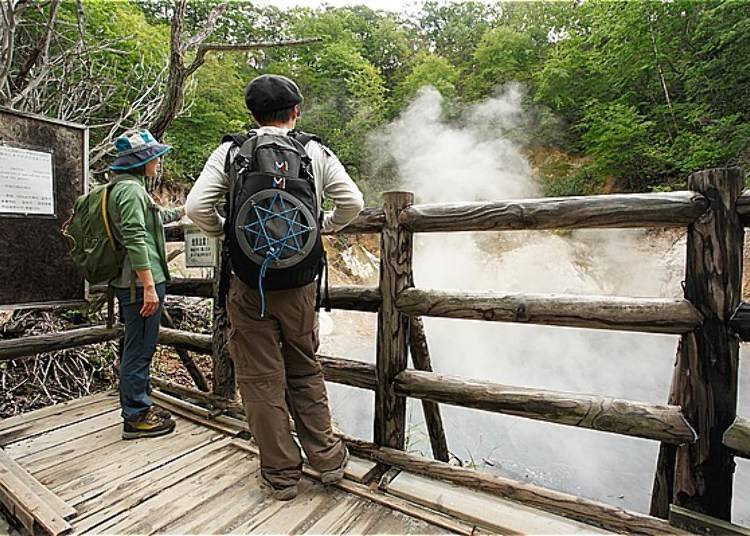
Until 2011, the amount of water erupting from the bottom of this marsh increased and decreased so frequently, at some points it seemed to practically explode, spurting the hot water all around. I may seem calm here, as the water hadn't done anything of the sort, but I remained wary just in case.
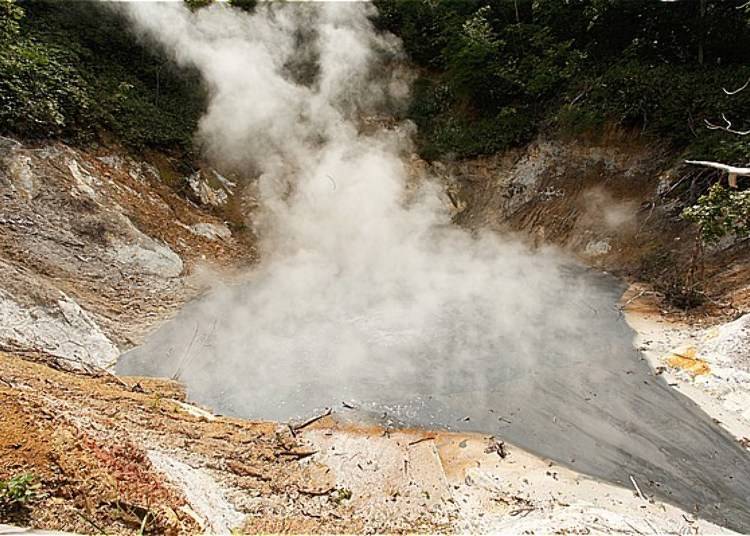
After checking out Taisho Jigoku, we headed to Yunokawa River.

The wooden boards lining the path made it comfortable and easy to walk, however there were many places without a fence, so caution is advised.

A short 5 minute walk from Hell Valley brings you to the Oyunuma River Natural Footbath.
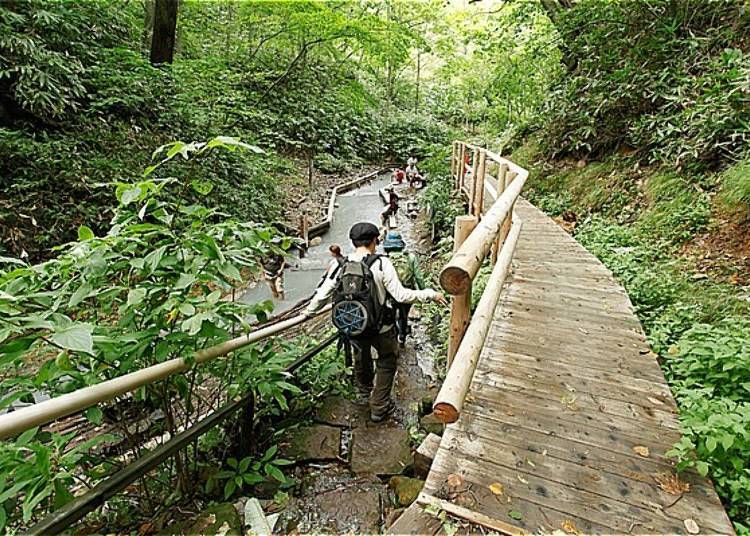
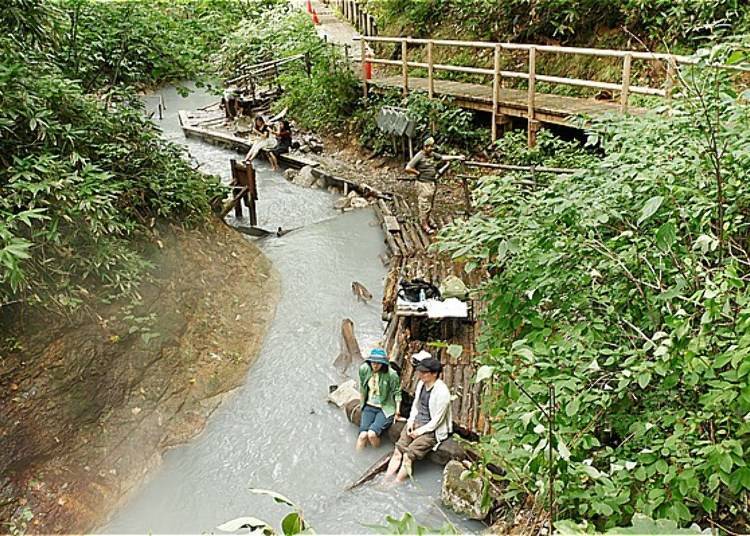
Mr. Kobayashi lent me an aluminum sheet to sit on since it was wet.

We took off our shoes and socks, rolled up our pants, and headed down to Yunokawa!
“Ouch!”
It was so much hotter than I expected, I couldn’t help but let out a little yelp. But though it started off feeling hot and tingly, I acclimated within a couple of minutes.
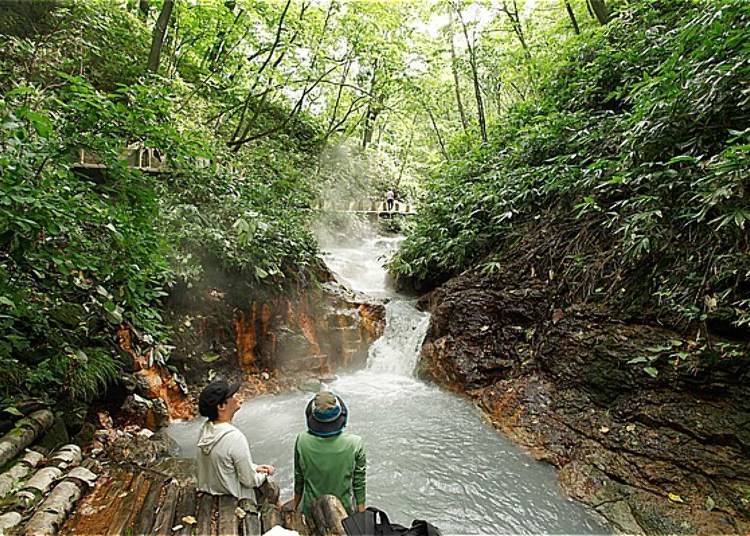
We headed towards the gray-colored river. Because of the color, it is difficult to see the bottom, so proceed with extreme caution.
The area we walked through only reached our calves, but other parts of the river can reach high enough to even wet your pants! And it’s not just the depth, but there are also certain spots in which the temperature is much higher, too!
Indeed it was a “hot water river!”
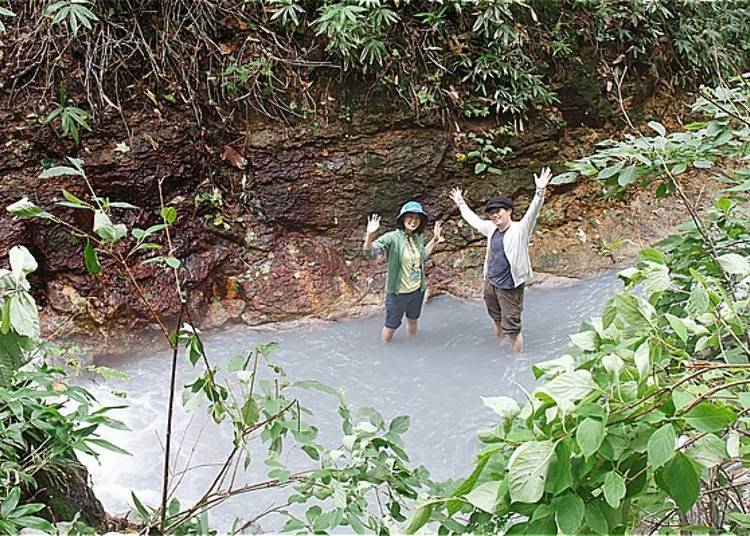
Here we are enjoying this hot water footbath in the middle of the forest. The fatigue from walking for nearly two hours had completely washed away! Also, this place maintains it beauty throughout spring, summer, fall, and winter, so it is truly a wonderful location to visit anytime!
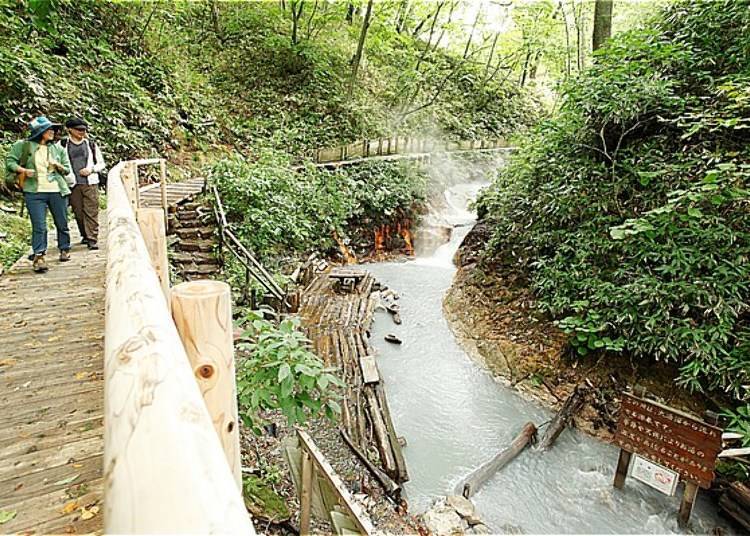
After the footbath, we returned to the hot spring town from which we started in a matter of 20 minutes. And with that, the guided tour of Noboribetsu Onsen was complete.
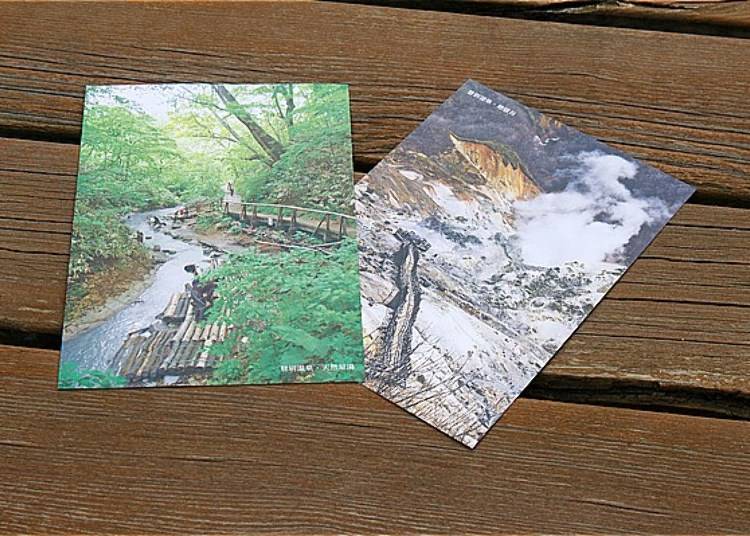
Walking amongst all these springs and geysers, feeling the power of the volcanic activity spread before my very eyes, it was as if I had uncovered the mysteries of the earth.
I truly believe that Noboribetsu Onsen is a hot spring to be noted indeed.
And above all, nothing replaces the authentic, magical experience of enjoying a natural footbath right in the river. This geyser watching experience at Noboribetsu Onsen was truly magnificent – one of the best experiences of my life.
*The guided tour is only provided in Japanese and English.
Geyser Watching Period: March-April, Daily at 10:30AM and 2:00PM
Length: Approximately 2 hours 30 minutes, Reservation required
Cost: Adult (Middle School age and above) 5000 Yen, Children (3 years – elementary school age) 3500 Yen (Tax included)
Tour Times: 9AM, 11AM, 1PM, 3PM
Business Hours: 8:30AM – 6:00PM
Closed: Always open
-
Noboribetsu Gateway Center登別ゲートウェイセンター
- Address 〒059-0551 北海道登別市登別温泉町26 道南バス登別温泉ターミナル内/Dōnan Bus Noboribetsu-Onsen Terminal, Noboribetsu Onsencho 26,
- Phone Number 0143-84-2200
Written by : Nobuhiro Kawashima
- Area
- Category
*Prices and options mentioned are subject to change.
*Unless stated otherwise, all prices include tax.
Popular Tours & Activitiess
Recommended places for you
-
Appealing

Kanemori Red Brick Warehouse
Shopping Malls
Hakodate
-
Appealing

Rukku and Uohei
Izakaya
Sapporo / Chitose
-
Appealing

Otaru Canal
Rivers, Lakes & Canyons
Otaru
-
Appealing

Sapporo Ramen Yokocho
Ramen
Sapporo / Chitose
-
Appealing

Shirogane Blue Pond (Aoiike)
Rivers, Lakes & Canyons
Furano / Biei / Sounkyo
-
Appealing

Shiroi Koibito Park
Theme Parks
Sapporo / Chitose
-

7 Iconic Hokkaido locations that will make your Instagram shine
by: Himanshi Shah
-
Ad

Smart Ways to Avoid Crowds and Enjoy a Safe, Comfortable Trip to Noboribetsu Onsen
-

Beyond Hakodate and Matsumae: Enjoy the Hidden Gems of Hokkaido’s Donan Area
-
Ad

Smart Ways to Avoid Crowds and Enjoy a Safe, Comfortable Trip to Otaru.
-

Expert-Recommended: 9 Hakodate Hotels Serving Up the Best Breakfasts in Town
by: Nobuka Kawashima
-

Scenic Road Trip from Hakodate to Matsumae: Stunning Views, Traditions, and Tasty Delights
by: Nobuka Kawashima
-

Kichijoji – Explore Tokyo’s Top-Rated Stylish Suburb in Half a Day!
-

Lake Shikotsu Guide: Easy Sapporo Day Trip To See Spectacular Natural Views of Hokkaido's Pristine Lake!
-

Hakodate 2-Day Itinerary for Exploring Japan's Foodie North!
-

10 Fun Activities and Magical Places in Furano - According to a Singaporean Expat
-

Noboribetsu Jigokudani: Guide & Best Things to Do in Hokkaido's Mysterious 'Hell Valley'!
-

Sapporo New Chitose Airport (CTS): Complete Guide to Restaurants, Souvenirs, Shopping & More!
- #best sushi hokkaido
- #things to do hokkaido
- #best ramen sapporo
- #what to bring to japan
- #new years in tokyo
- #what to buy in ameyoko
- #japanese nail trends
- #what to do in odaiba
- #onsen tattoo friendly tokyo
- #daiso
- #best sweets otaru
- #japanese fashion culture
- #best nature furano
- #japanese convenience store snacks
- #best japanese soft drinks















